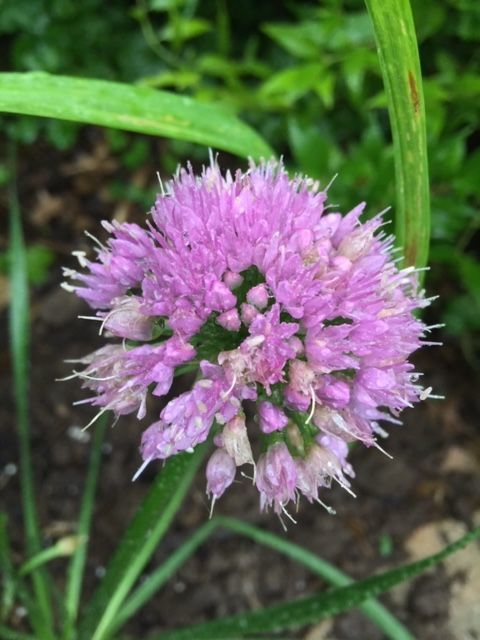
Susan Esche has been facing the same problem as many gardeners: hungry deer.
My rural garden near a lake is becoming increasingly popular with the local deer, and this is shaping my design and plant options. Aside from a 20×20 fenced area for vegetables, everything else must be sufficiently unpalatable to survive here. Phlox is being replaced by agastache, Brazilian verbena (Verbena bonariensis, Zones 7–11 or as annual), artemisia, and cleome. The daylilies will be given away and replaced by nepeta, lamb’s ears (Stachys byzantina, Zones 4–7), bugleweed (Ajuga reptens, Zones 3–10), and Millenium allium (Zones 5–9). Purple basil, lantana, and variegated sage replaced pots of coleus. Ferns and Lenten roses (Helleborus sp.) replaced hostas in the shade. The smooth hydrangea (Hydrangea arborescens, Zones 3–9) is not immune to nibbling, but that midsummer pruning sometimes brings more flowers on the fresh growth. The southern magnolia (Magnolia grandiflora, Zones 7–11) gives year-round structure, as do golden false cypress and Hicks Yew. So far, the stately oakleaf hydrangeas (Hydrangea quercifolia, Zones 5–9) have escaped their notice, but I have already decided upon buckeyes (Aesculus sp.) if I have to replace those. I dare you to nibble on that, Bambi!
 Red buckeye (Aesculus pavia, Zones 4–8) is beautiful—and toxic. Deer leave it alone.
Red buckeye (Aesculus pavia, Zones 4–8) is beautiful—and toxic. Deer leave it alone.
 Brazilian verbena is perennial in Zones 7–11 and often self-sows year after year in colder zones.
Brazilian verbena is perennial in Zones 7–11 and often self-sows year after year in colder zones.
 Lamb’s ear has fuzzy leaves unpopular with deer, and small flowers very popular with bees.
Lamb’s ear has fuzzy leaves unpopular with deer, and small flowers very popular with bees.
 Allium ‘Millenium’ is a beautiful flower, and like most members of the onion genus, it is unpalatable to most deer.
Allium ‘Millenium’ is a beautiful flower, and like most members of the onion genus, it is unpalatable to most deer.
 Clouds of purple verbena and pink and white cleome (Cleome hassleriana, annual) make a beautiful, deer-resistant planting.
Clouds of purple verbena and pink and white cleome (Cleome hassleriana, annual) make a beautiful, deer-resistant planting.
 A huge white flower opening in the evergreen, and deer-resistant, southern magnolia.
A huge white flower opening in the evergreen, and deer-resistant, southern magnolia.
 Agastaches have colorful flowers, and new varieties are always coming on the market. Like many plants with fragrant foliage, agastaches don’t count many deer as fans.
Agastaches have colorful flowers, and new varieties are always coming on the market. Like many plants with fragrant foliage, agastaches don’t count many deer as fans.
 Smooth hydrangeas are usually not on the top of deer’s most-loved list, so they can often do well despite the occasional nibble.
Smooth hydrangeas are usually not on the top of deer’s most-loved list, so they can often do well despite the occasional nibble.
Have a garden you’d like to share?
Have photos to share? We’d love to see your garden, a particular collection of plants you love, or a wonderful garden you had the chance to visit!
To submit, send 5-10 photos to [email protected] along with some information about the plants in the pictures and where you took the photos. We’d love to hear where you are located, how long you’ve been gardening, successes you are proud of, failures you learned from, hopes for the future, favorite plants, or funny stories from your garden.
If you want to send photos in separate emails to the GPOD email box that is just fine.
Have a mobile phone? Tag your photos on Facebook, Instagram or Twitter with #FineGardening!
You don’t have to be a professional garden photographer – check out our garden photography tips!
Do you receive the GPOD by email yet? Sign up here.














Comments
Excellent solutions- and very attractive too
Kudos for your ingenuity in outwitting Bambi while still keeping the garden appealing to people.
Love your verbena & cleome - a great combo.
Hi Susan. Not sure if it is too late for you to receive my appreciation for your sharing of info. I, too have to plan around deer (and a small elk herd!). Love the look of your plantings, and have used several myself. Have had great luck with Agastache Blue Boa. Going to keep your successes on my list to try. Again, thanks. I used to always get right to the GPOD, but sometimes I get behind getting to my emails!
Log in or create an account to post a comment.
Sign up Log in